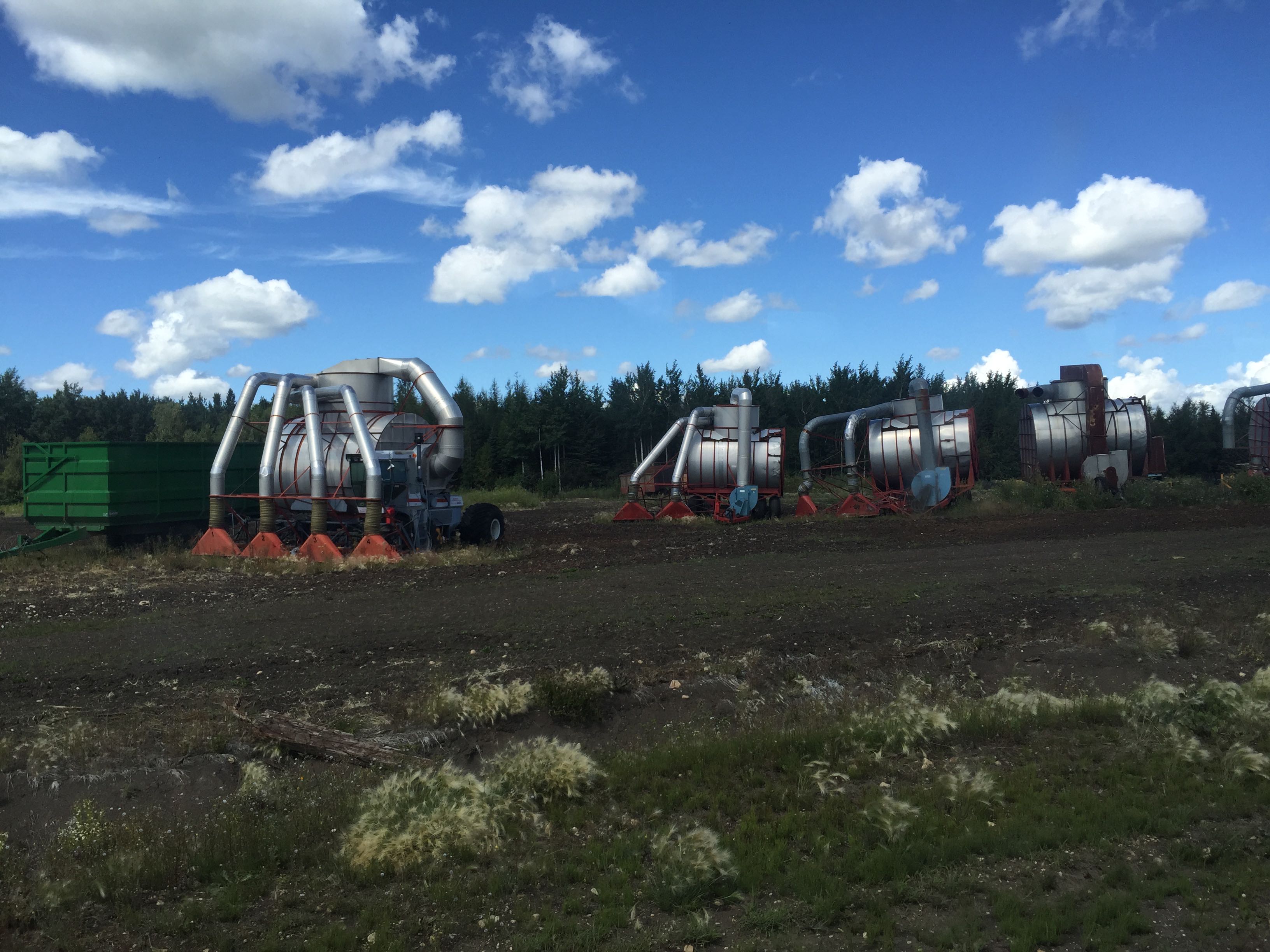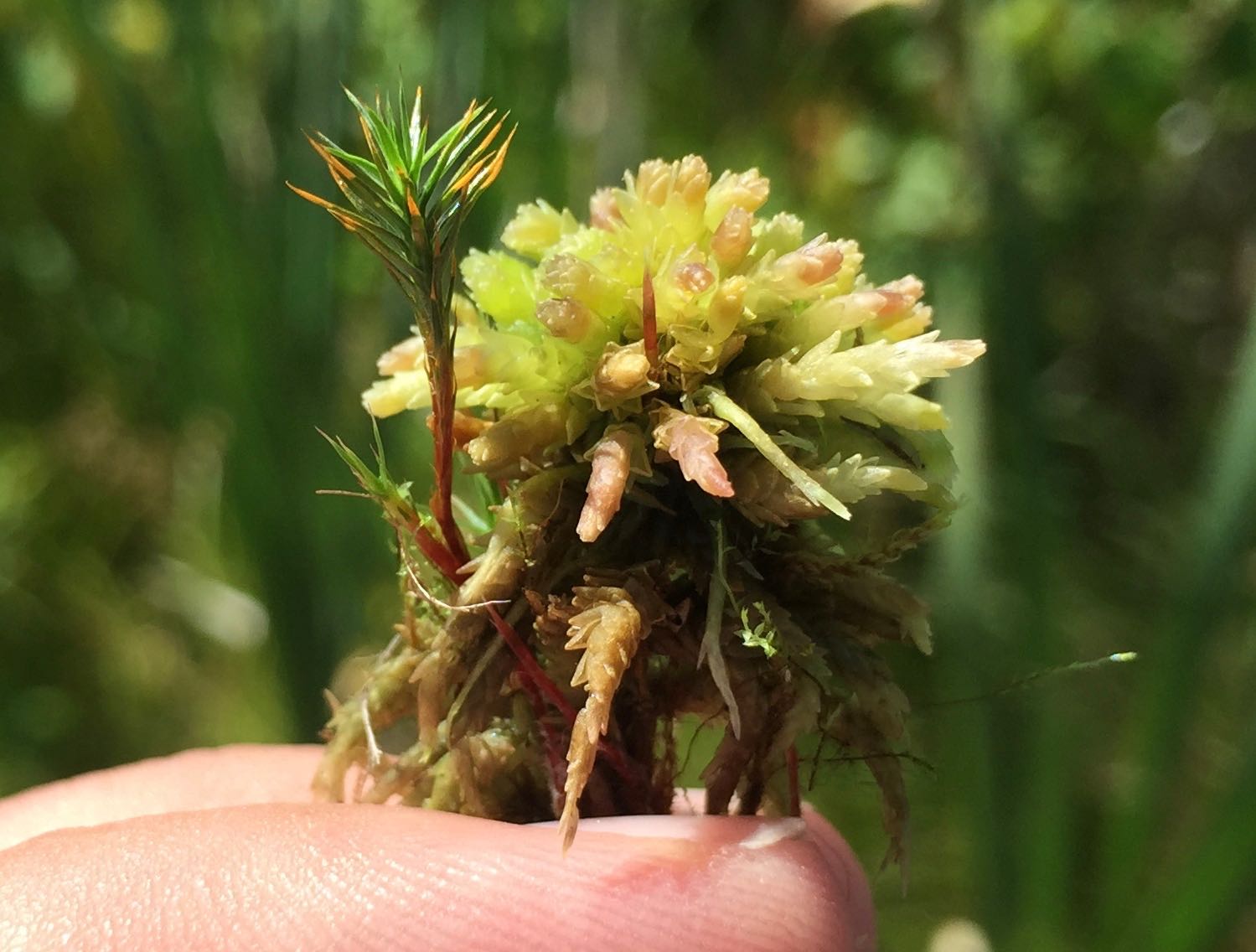For someone passionate about Sphagnum, the thought of visiting a place where peat moss is harvested for commercial use might seem a little like an ornithologist visiting a sport-hunting facility, or a mollusk researcher watching a big diesel spewing ship dredge a river channel. But when I saw that a tour of SunGrow’s peat harvesting and restoration facility in Seba Beach was on the menu at the 2015 Botany conference, I signed up instantly.
I must admit that I was initially skeptical; although it is sometimes classified as a renewable resource, peat forms very slowly. Bog growth rate has been measured at about 1 cm per year, and the typical depth of usable peat in Canada is 3-5 meters. So even if conditions instantly returned to peat accumulation, it would take hundreds of years to regenerate. This makes it more comparable not to other renewables like switchgrass or even loblolly pine, but rather closer on the renewable scale to coal.
I was put at ease by Dr. Line Rochefort, of Laval University in Quebec, who conducted the tour. She has been working with peat harvesting companies for 25 years, advising them on best practices. She helped organize the Canadian Sphagnum Peat Moss Association, a collection of researchers and companies around Canada with a stated interest in responsibly restoring peatland habitat after harvesting. This is not mandated by the Canadian government, which only requires that the site be returned to a wetland. But something as simple as filling in the ditches would never return the peatland to its original state.

Line Rochefort speaks to the group about peatland restoration
Essentially, the restoration of peatlands comes down to one argument: peatlands are going to get harvested, as long as there is demand for peat in the horticultural industry (the association estimates peat harvesting is worth $337 million annually). It would be much better if we (as humans) did this as responsibly as possible, rather than by taking all we could and running away. Peat harvesting has the potential to impact the environment in the short term, through wetland destruction; and long term– removing a peatland causes a net increase of carbon emissions beyond just the removal of living plant material.

Peat harvesters are essentially giant vacuums
After harvesting, even if the drainage ditches are plugged, the peatland cannot recover. Dr. Rochefort mentioned visiting peatlands in Colorado that had been harvested with no attempt to restore them; after 140 years, they still look like barren wastelands. This is because Sphagnum peat moss, the most important plant for northern boreal bog peatlands, cannot recolonize the peatland without some help. Dr. Rochefort told us that when she searches for a “donor site”– a peatland that can have its top layer removed and distributed atop harvested peat for reclamation– the most important plant is not Sphagnum, but another moss, Polytrichum.

Polytrichum (left) and Sphagnum (right). Stubby bryologist fingers for scale.
Polytrichum is an upright moss with hardy “stems” that form a matrix onto which Sphagnum can grab hold and begin to build hummocks and accumulate peat. In the first phase of peatland restoration, material from the donor site is spread onto a harvested peatland in a 1:10 ratio (one hectare of donor site can be spread across 10 hectares of harvested peatland). Sphagnum will regenerate from broken fragments, but have a very hard time establishing on its own. Polytrichum, meanwhile, will easily germinate from its very abundant spore bank in the newly spread donor site material. Dr. Rochefort said that Polytrichum is so important that they make sure to add rock phosphate to the site to help Polytrichum spores germinate.
During the tour, we visited three sites: one that had been reclaimed using their procedure in 2009, another that had been reclaimed in a less “rigorous” way in 1994, and a donor site. The more recent reclamation site had an abundance of all the types of mosses you would see in a mature bog: Sphagnum magellanicum, Sphagnum fuscum, Sphagnum angustifolium, Aulacomnium palustre, and a few “brown mosses” such as Tomenthypnum and Drepanocladus. The vegetation had recovered nicely, but did have some species that did not belong in a bog: cotton grass and small birch trees were the most obvious. Dr. Rochefort said that based on earlier restorations, these plants were likely to die out as the Sphagnum took ahold of the habitat.
The elder reclamation site was more interesting from a botanizing perspective. Near the road there was a part where no moss mixture had been spread, and it looked like the wasteland Dr. Rochefort described from Colorado. Just a few feet away, there was a lush and healthy lawn of Sphagnum, perhaps ten species living happily. Although it wasn’t a true raised bog– that might take hundreds of years for the peat to regrow– I would not have been able to tell it was bare peat just 20 years earlier.
The peat extraction process is pretty interesting itself. They actually harvest in the dead of winter, once everything is frozen and covered with snow. Then they use a harrowing device to remove the top 20 cm of plant material– everything including mosses, grasses, and even black spruce trees! This material is kept in a pile for the winter and spring; the water from the snow and the mulch from the woodchips helps maintain the plants while they await spreading on a new peatland. At this point someone asked about the impact of cutting down all the spruce trees. “Compared to the peat moss,” Dr. Rochefort said, “the carbon produced by the spruce is negligible.” Such a difference compared to other restoration efforts, where mosses are barely considered, here is perhaps the ultimate situation in which moss matters.
In the spring, the peat is turned and dried until late summer. Then, extremely large driving vacuums come along and suck up the peat. They turn over the peat behind themselves, and once this layer dries, the process can be repeated. They may get 20-30 years of peat harvest from a single plot, and after this is done, plant material from a donor site will be spread to encourage restoration.
Overall, I left with a positive opinion of the efforts being done at SunGro. I won’t say too much about the political and business implications of peat harvesting, as I will leave that to those who are more informed on those issues. From a botanist’s perspective, and one who has some experience with natural peatlands, their efforts are commendable. I thoroughly enjoyed the tour, not least because I finally got the opportunity to get away from the computer and look at some plants!